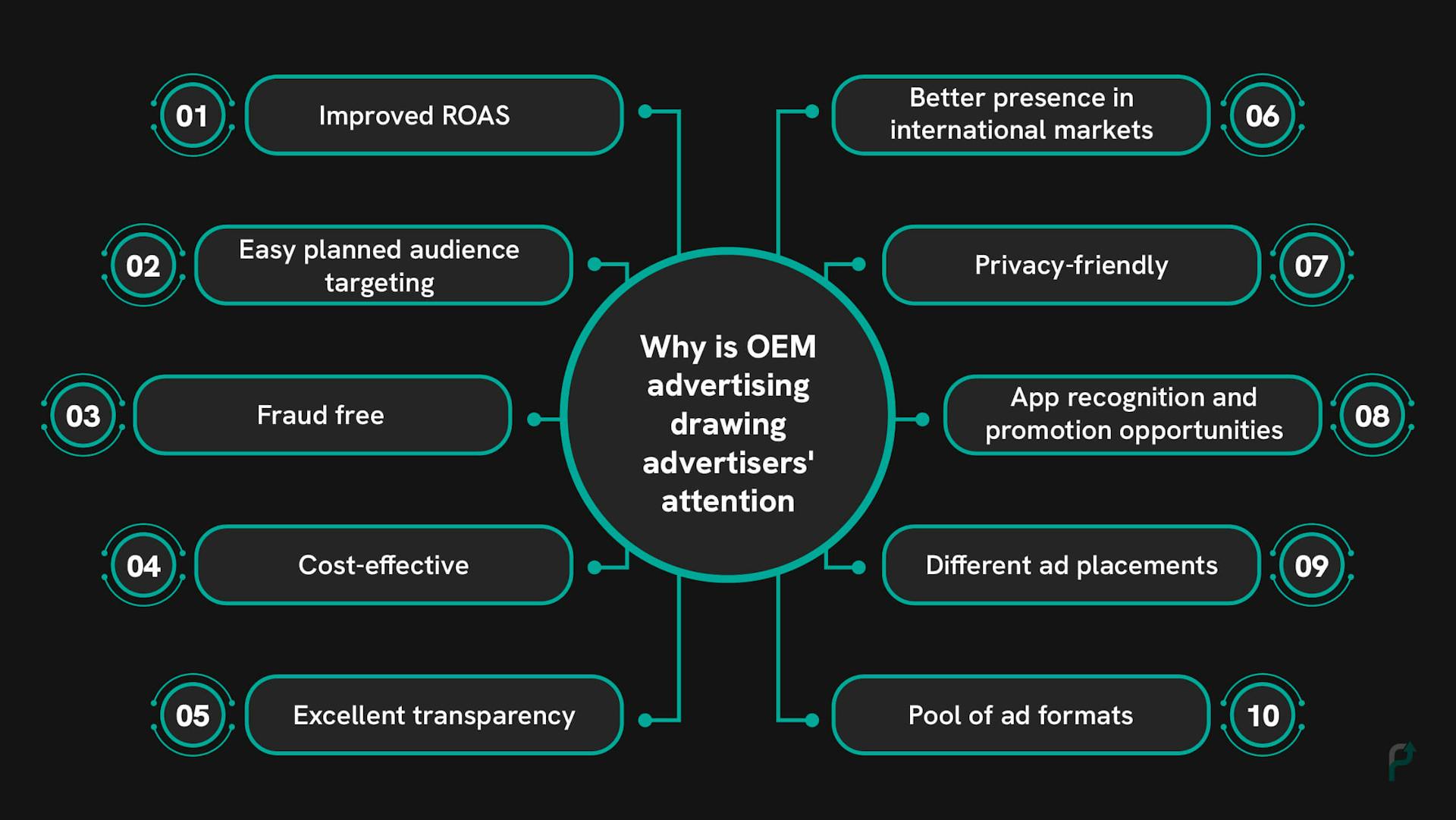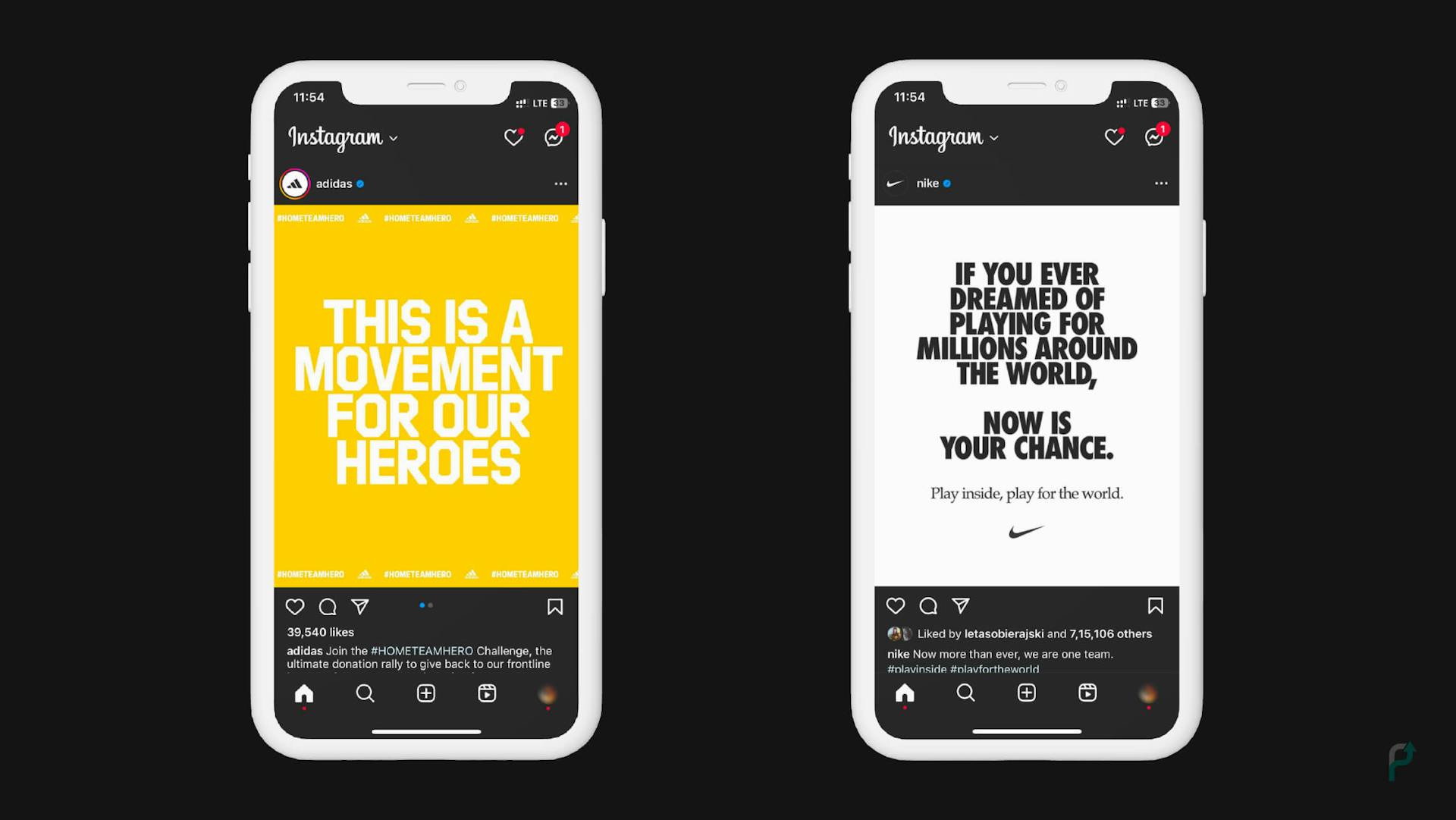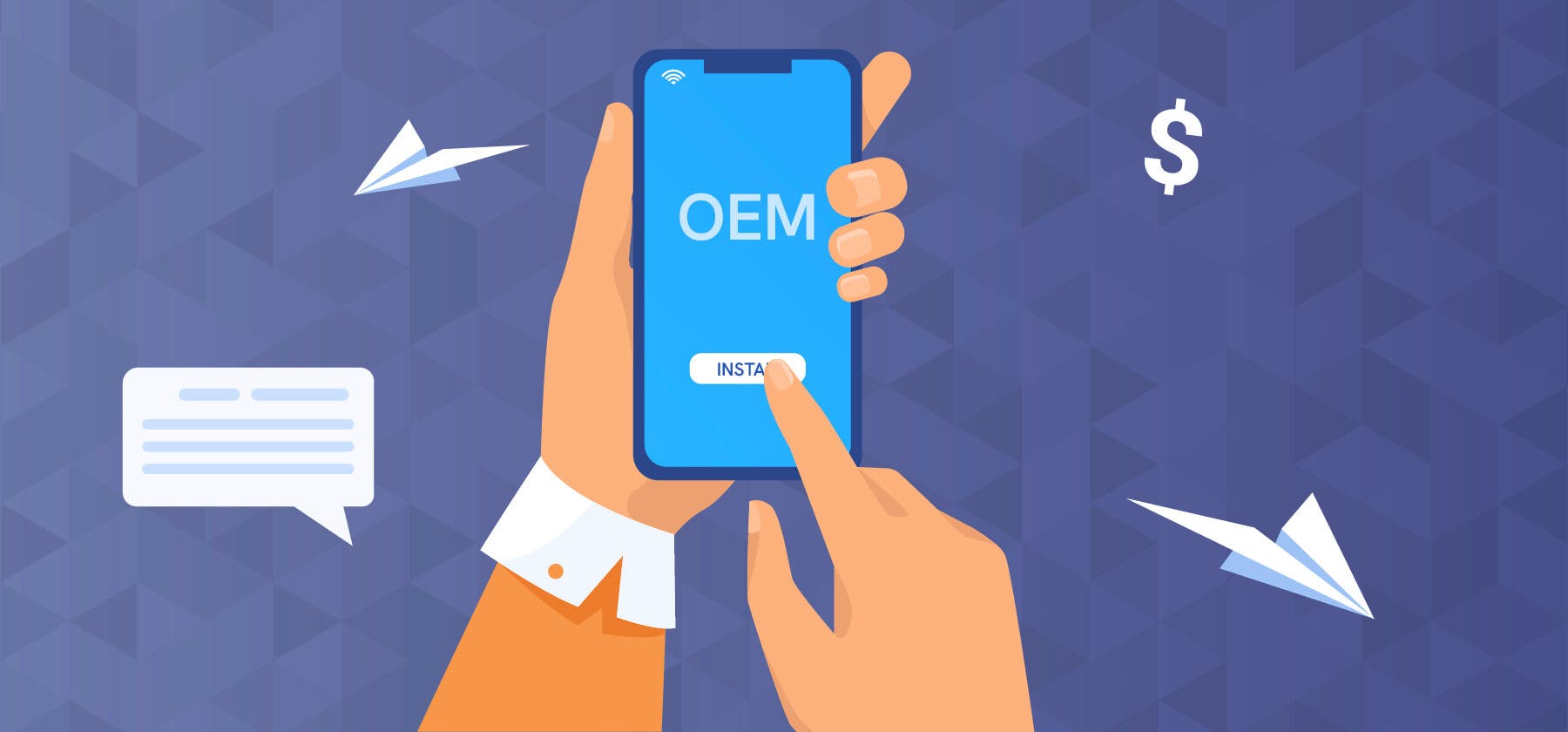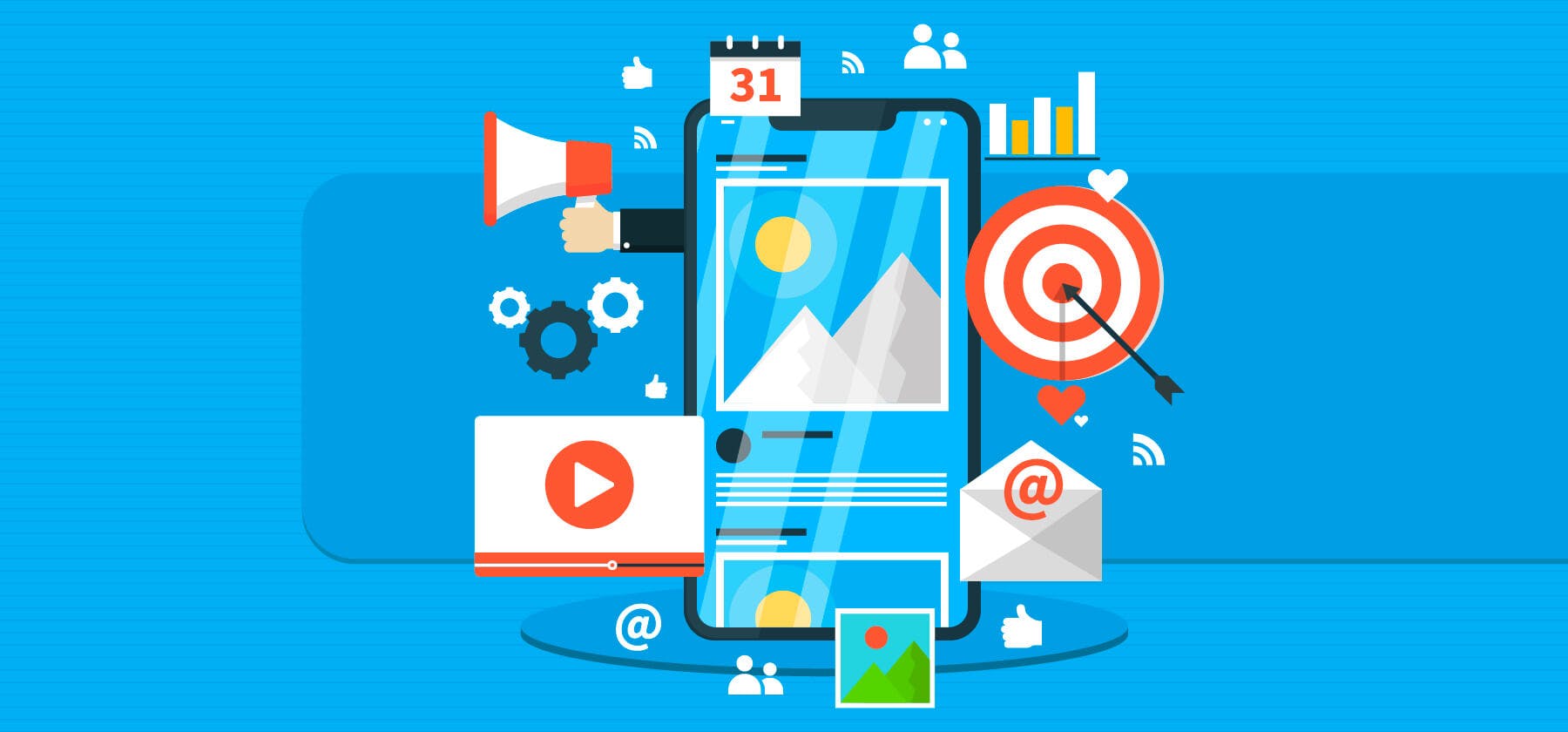- OEM advertising emerges as a cost-effective and fraud-resistant option. It strategically places ads on OEM platforms to reach users at crucial points in their customer journey.
- OEM ads offers benefits like easy market expansion, cost-effective user acquisition, high transparency, and targeted demographics.
- Advertisers leveraging OEM campaigns experience increased app installs, improved ROI, and a competitive edge in the app market.
It is getting difficult every day to attract new users to your apps due to the tough competition and more than 8 million apps accessible for iOS and Android. Although many user acquisition campaigns concentrate on the duopoly of Google and Facebook, there are other alternatives to traditional search and social, including OEM placements. So, to boost new app installs, marketers must consider all available options.
OEM (Original Equipment Manufacturer) advertising is making headlines as it slowly but surely is transforming the mobile ecosystem, offering a viable and profitable alternative to conventional play stores. Due to the exceptional target audience and low fraud risk associated with OEM inventory, OEMs are a cost-effective option for all advertisers.
With OEM advertising becoming popular, advertisers can strategically place their ads at key customer touchpoints to acquire untapped consumers along the customer journey. Consumers' curiosity is likely to be piqued by these advertisements on OEM platforms, and businesses will see an increase in their ROI (Return On Investment) if customers respond to the call to action.
To achieve their marketing KPIs, such as app installs, site visits, leads, downloads, sales, and more, advertisers from different sectors, including travel, e-commerce, and gaming, are increasingly leaning on this cutting-edge advertising solution.
Understanding OEM advertising will help us move forward with better clarity.
To begin, let's first understand OEM.
Drive growth through strategic OEM ad campaigns.
What is OEM
OEM (Original Equipment Manufacturer) refers to a business that makes its own products in-house. OEMs are advertising platforms created by device makers, mobile carriers, and retailers for the mobile app market. Since OEMs define the hows, whens, and whys of mobile device usage, they are critical to the app economy.
Brands like Oppo, Vivo, Samsung, and Xiaomi are examples of Original Equipment Manufacturers (OEMs) in the smartphone industry. These companies have created app stores to collect audience data and provide real-time analytics.
What is OEM Advertising
OEM advertising, sometimes known as mobile app advertising in a common language, is the next big thing in user acquisition traffic sources for advertisers. OEM advertising, which is fundamentally on-device advertising, involves showing the user a pre-installed app on their phone or suggesting an app within the device.
The all-encompassing approach for using ad spend to boost incremental ROI is OEM advertising. Mobile OEM advertising allows advertisers to promote apps directly on OEM-specific app stores or OEM mobile devices.
Without violating the users' data privacy, reaching the user at a particular time allows for specific user targeting based on the device model, geographic data, age, and gender.
OEM ads fall into two categories:
-
Pre-installed apps, such as the weather app or app stores.
-
Recommendations that are sent to users when they use apps or initiate an event during their mobile device user journey.
So, OEM ads should not be viewed as creatives but rather as the app icon and its placement on the device. OEM advertising is part of a user acquisition campaign and is often known as a pre-installed app campaign.
Access to OEM traffic is attainable through a variety of platform types. There are three groups that they fall into nowadays.
Platforms supplying OEM traffic
| Original technological solutions | Ecosystems | Advertising platforms |
|---|---|---|
| Oppo | Ironsource Aura | Xoom |
| Vivo | Digital Turbine | Bikiko |
| Xiaomi | Appnext | |
| Huawei | Supply-side platforms (SSPs) integrate with advertising platforms (like Xoom or Bikiko) to provide paid traffic from manufacturers. |
The first category consists of Android smartphone manufacturers like Xiaomi, Huawei, and others who have developed original technological solutions.
The second group is integrated into the Android operating system through an ecosystem of applications (APKs). An APK's integration into a smartphone operating system is a time-consuming, expensive process that can take up to 1.5 years. These platforms function as direct mediators between manufacturers and advertisers and are classic OEM channels that drive traffic to end users' devices.
Advertising platforms are the third group; they buy traffic from manufacturers and integrate it with service-side platforms(SSPs), which are third-party technology platforms. Even if OEM traffic is not the only traffic from these sources, you can still get great ROI with the right optimization strategies.
How OEM Works
In these OEM campaigns, marketers work alongside OEMs to get their applications pre-installed on the OEM portable devices. In other words, your app will already be set up on consumers' smartphones before they buy or install them. This can improve your app's visibility, and consequently, brand reputation. You will experience massive growth in views due to your application's availability across multiple platforms, which will raise brand awareness.
Furthermore, you may leverage these campaigns to support other initiatives that help your business and apps, including conventional marketing and App Store Optimization (ASO) strategies.
Additionally, you may increase the number of users by concentrating your efforts in certain areas. Moreover, you may guarantee that OEMs only install your apps on the handsets belonging to your target market.
With personalized pre-install marketing, you may reach the relevant users at the appropriate moment. You may, for instance, concentrate your marketing efforts on a particular technology your target market is most likely to buy and use.
To reduce the intrusiveness, OEMs install these apps when the user first switches on the phone and begins the authentication process. Depending on their demographics, users receive a selection of apps that they may find interesting.
Struggling to grasp OEM? OEM made simple: Advertise smarter, not harder, with our tailored solutions.
The Importance of OEM Advertising
With an OEM marketing strategy, advertisers may find high-quality customers, get exclusive ad space, generate leads, and make product suggestions in a safe and scam-free environment. Additionally, app businesses that advertise on OEM-based app stores have a competitive edge since they may reach a bigger, untapped target market.
Using an OEM marketing plan has the following benefits:
- OEM advertising helps you easily expand to new markets.
- Since OEMs have total control over every aspect of their advertising, the ecosystem remains free from fraud.
- OEM marketing provides high user acquisition at a lower Cost Per Install (CPI), making it simpler to achieve user acquisition objectives and increase Return On Ad Spend (ROAS).
- OEMs analyze metrics like impressions, clicks, and installs to maximize the effectiveness of their ad spend.
- Instead of seeming intrusive, OEM advertising seems organic, natural, and value-generated.
Why is OEM advertising drawing advertisers' attention
With quality ad spend on the rise due to OEM advertising, the digital marketing landscape has experienced a significant transformation, encouraging businesses to pursue better branding and performance opportunities.
 How OEM Grabs Advertiser's Attention
How OEM Grabs Advertiser's AttentionHere are some ways OEM is drawing an advertiser's attention:
-
Improved ROAS
Based on user behavior, OEM advertising enables advertisers to optimize customized campaigns by breaking down ad frequency. Hence, they can effectively utilize their advertising budget, increase ROAS, and deliver high-quality coverage while also improving campaign results. This will make it easier to meet their user acquisition targets and, as a result, increase return on ad spend.
In addition to utilizing demographics that connect with the particular inventory, this enables them to rebalance their marketing mix. Further, it helps advertisers make smart findings about the ad spend, increases ROAS, and delivers high-quality reach and improved campaign results.
-
Easy Planned Audience Targeting
With OEM marketing, it has become simpler for marketers to promote advertising campaigns and pinpoint the right demographic using the best available inventory.
Given that OEM advertising uses advanced targeting, marketers may develop a high-quality audience pool by concentrating on user behavior, demographics, language, and promotion applications focusing on user coverage, retargeting, keyword, and GAID targeting.
Due to the abundance of targeting options, marketers may learn about users' past behaviors and related analytics, which helps acquire new users from similar inventory. As a result, they can create an OEM campaign for a targeted group of consumers and quickly expand their user base.
-
Fraud Free
Mobile OEM essentially eliminates fraud because there are no additional layers between users and advertisers. Because of this, advertisers consider OEM a reliable channel and a cost-effective method to spend their advertising budget.
There is no deception since OEM traffic is highly transparent. Many people wrongly blame OEM traffic for the poor quality of in-app sources. That is untrue because OEM traffic is fraud-free with real-time user acquisition due to its user-friendly design.
A direct channel, an APK solution, or an SSP (that sends traffic from a manufacturer to a user directly) make up the technological stack of an OEM channel. The first two OEM channel concepts send traffic straight from the manufacturer to the user, making OEM channel traffic visible and simple to monitor.
-
Cost-Effective
OEM marketing is ideal for businesses of all sizes and budgets. Working with OEM sources delivers the best results despite budget limitations because their CPA is lower than other resources, and their conversion rate is generally higher.
With OEM advertising, budgetary decisions are acute since they help advertisers target relevant users who are genuinely interested because mobile OEM models only charge for installs. In addition, mobile OEMs offer a reliable way to find ideal consumers during uncertain economic times.
-
Excellent Transparency
OEM advertising is much more appealing to advertisers globally since OEMs are highly transparent about traffic attribution and abide by GDPR. OEM ad campaigns are better capable of achieving their performance targets because of greater transparency of OEM traffic and, consequently, the accuracy of projections.
-
Better Presence in International Markets
For a large number of mobile OEMs who profit from their inventory, market share is rising. Currently, more than 60% of the market share in Europe belongs to OEMs that want to advertise their app stores, giving advertisers access to millions of users in both established and developing nations.
-
Privacy-Friendly
OEM placement, solely available on Android, is a privacy-friendly approach to discovering new user sources in non-conventional app stores in the era of App Tracking Transparency (ATT).
Mobile OEMs will still let you perform optimization based on advertising ID even if Google deprecates it to challenge advertisers to execute effective campaigns outside the Google ecosystem. Further, OEM attribution will not get affected and will still have full optimization potential, so advertisers who don't want to see a second iOS fiasco on Google should act immediately.
-
App Recognition and Promotion Opportunities
The pre-installed apps on OEM smartphones help identify the most often downloaded apps by users. OEM app stores provide marketers with substantial incentives through integrated app stores to promote and market their applications. They use this strategy to gain advertisers' trust and solidify their position as their go-to resource for mobile app advertising.
These apps, which include short video apps, RMG apps, and social networking apps targeted at a particular user base, may be used by advertisers to acquire a range of objectives.
-
Different Ad Placements
OEM has taken the market by storm by presenting efficient ad placements and branding opportunities at several touchpoints. OEM Ad Placements primarily concentrate on Pre-Install/Pre-Load, Recommended Apps, Hot Downloads, Icon Promotion, and Browser-Based Promotion in a fraud-free environment. This facilitates marketers to pick the best-performing source to make attainable marketing objectives.
-
Pool of Ad Formats
Throughout the device lifespan, OEM advertising takes place across several touchpoints, supplying advertisers with several ad formats, including Banner Ads, Push Ads, Tiles/Icon Ads, Search Ads, Splash Ads, etc.
Such ad formats make it simple to reach and engage with users while focusing on specific devices and geolocations. These deliver more value and give users the freedom to choose and download apps they use for longer and on purpose. This, in turn, improves user retention and engagement rates and maximizes ROAS.
Optimize app visibility with OEM variety.
How OEM advertising can help improve app installs
Since more users pay attention to and use pre-installed apps, OEM advertising will inevitably boost app installs. Although the industry's standard conversion rate is up for discussion, most sources will tell you that it is typically between 1% and 2% for new users that download apps from stores.
Furthermore, you already have the user's trust and perhaps their attention with pre-install marketing, OEM advertising helps increase app installs — especially if your pre-install endeavors are well-targeted. Also, you'll be able to lower other, more costly, but ineffective mobile marketing actions as a result. In-app purchases and other conversions will probably increase as a result of this.
Also, Ad formats are optimized to acquire high-quality app installs quickly. These ads may appear on both premium third-party apps and OEM-owned app marketplaces. With targeting elements like device price range, location, and app category, brands can effectively reach an untapped consumer base.
Successful OEM Advertising Campaigns
The app marketplace has evolved into a terrific platform for showcasing products and services, thanks to the explosive growth in mobile phone usage, especially with the advent of tech-savvy mobile applications.
The app industry, however, is quite competitive as there are millions of apps to pick from, so it's vital to find your position.
Creating an app doesn't guarantee unprecedented success. You require more than a beautifully designed and compelling app to stand out in such a crowded market and attract the downloads you deserve. To achieve this, you must take care of several points to have successful OEM advertising campaigns, such as developing a marketing plan and utilizing the relevant targeting techniques.
App install ads are one of the best ways to promote your app, even if there are many ways to get more installs and top the charts, such as social media and powerful marketing campaigns.
Wondering what app install ads are? Read our detailed blog on app install ads here.
Let's take a glimpse at some of the most effective omnichannel marketing campaigns that revolutionized the OEM marketing industry.
Examples of successful OEM advertising campaigns for app installs
Nike
Being part of a team and participating in team sports is at the core of Nike's brand. Its free apps are one of its most effective marketing platforms for propagating these ideas.
To get people to accept the stay-at-home directive during Covid peak days, Nike created the "Play inside, play for the world" ad. Nike made an Instagram post emphasizing the necessity to adhere to social distancing before shutting a number of its stores globally.
With a resonating core message and the current hot topic, Nike's success was inevitable as it increased its user base through emotional advertising through its Instagram post. Nike was able to get thousands of new app users thanks to this promotion and free premium access.
 Examples of successful OEM advertising campaigns
Examples of successful OEM advertising campaignsAdidas
Adidas is the next brand on our list, and its campaign during the COVID-19 pandemic highlighted the value of social isolation.
The #hometeamhero challenge pushed users to download the app and follow professional athletes' fitness regimens. This activity emphasized the value of being in shape and belonging to a community after the closure of the majority of sporting events and gyms.
The company urged participants to prepare for the recently thrown health challenge. Further, they also pledged to contribute $1 to the World Health Organization for every hour users were active as an added benefit.
Adidas combined the opportunity to stay active with the potential to help solve a global issue. You must agree that it is a fantastic marketing concept.
TikTok
Now let's talk about TikTok, which has never ceased expanding since its launch. It accomplished 3 billion downloads for the first time among non-Facebook apps, and since the year 2019, TikTok has been able to increase its user base from 1 million to 6 million, a 6x increase.
We'll speak about "It Starts on TikTok" today, one of TikTok's many effective advertising campaigns. Radio, Facebook, Twitter, Instagram, linear TV, digital out-of-home, and other media were all used for this campaign. Originally intended for the US market, it was translated for markets in Asia, Europe, and Latin America after becoming a major success.
 Advantages of OEM Campaigns
Advantages of OEM CampaignsTips for Implementing a Successful OEM Advertising Strategy
When developing a marketing strategy for OEMs, it is essential to take into account some common patterns because OEMs frequently deal with nuances like extended sales cycles, niche user bases, complicated products, global reach and supply chains, multiple personas, and the need for CRM and other technical integrations.
Simply attracting visitors to your website is inadequate if you are an OEM. Although this is an ideal start, the extended lead time and complicated product-buying process call for a long-term engagement system. To accomplish this, each step of your strategy should focus on the fundamental concerns in your content and engagement initiatives.
Utilizing an inbound marketing strategy is the ideal marketing plan for OEMs to attract and retain customers. This entails developing resources that account for and streamlines the many stages of a prolonged buying process. By doing this, you may provide your audience with the information they need at the right time.
How to Implement a Successful OEM Marketing Plan
 Effective OEM Marketing Strategy
Effective OEM Marketing StrategyIf you want OEM advertising efforts to be successful, you should manage them similarly to other user acquisition strategies.
You may start by giving your campaigns a purpose to advance your business by following the steps listed below:
-
Establish benchmarks
Knowing where you are and where you are heading are two of the first elements in creating an effective OEM advertising plan. This includes thoroughly evaluating your current events and asking yourself and your team difficult questions about your OEM digital marketing strategy, like:
- What does Google think about our website?
- How are our contenders positioned in the market?
- Does our website deliver the knowledge and experience required to draw in the user and businesses we want to collaborate with?
- What does our team think of our website? Is it incorporated into the sales team's workflow?
- How well are our marketing initiatives doing right now?
-
Understand your target audience
Establishing buyer personas is necessary if you want to communicate your value proposition in your content and website. Your marketing team can guarantee that the leads it generates are high-quality and won't require your sales team to consume too much time qualifying them by identifying your Ideal Customer Profile (ICP).
-
Choose the right OEM partners
You can reach more mobile app users with the proper OEM partner than you could otherwise. Get a spot on new smartphones with their on-Device Ad Placements to swiftly raise brand exposure among your consumers and competition.
Your app will expand meaningfully through optimization if you have a successful user acquisition strategy. Diversifying your user acquisition channels will enable you to connect with new and relevant consumers.
By examining user acquisition channels, channels that don't perform well should be steered to ones that do. Analyzing your user acquisition statistics will help you identify avenues that need improvement.
-
Measure campaign success
After launching your OEM advertising campaign, you should gather and examine the data it delivers. Compare the outcomes to the targets you set and make the necessary adjustments to your campaigns if you notice any shortcomings.
As your brand grows and your user base increases, continuous improvements will help you get the most out of your efforts. As you get more expertise with them, you'll eventually be able to raise the ROI of your campaigns.
When evaluating the results of an OEM advertising campaign, there are three guidelines to follow, based on the unique technical features of OEM sources.
- Test several OEM sources first to see which one performs best, but don't switch up the sources while testing.
- Second, refrain from comparing OEM testing results with other performance sources.
- Third, within a month, the outcomes of an OEM advertising campaign should be attributed.
Accelerate app downloads with OEM solutions.
Key Takeaways
- OEM advertising will undoubtedly continue to be among the most compelling forms of advertising as technology advances.
- This medium gives app publishers and advertisers greater leverage, ensuring a higher Return On Ad Spend (ROAS) and enabling strategic targeting of unexplored markets.
- OEM marketing will be extremely meaningful in the advertising future, with a greater focus on Privacy.
- OEMs have complete control over device interface and content customization, ensuring that apps are useful and relevant to users.
- OEM advertising is a fantastic tool for performance-based campaigns when accuracy and quantifiable outcomes matter. The only thing now accessible in OEM sources is the advertising for Android mobile applications.
Final Words
OEM advertising has emerged as the next frontier in the mobile app ecosystem, an ever-evolving mechanism that encourages creativity and story-telling marketing practices in many ways. Modern technology is advancing, and OEM is redefining brand visibility since it offers several targeting possibilities that provide OEM advertising endeavors with a competitive advantage.
Additionally, it encourages trade and promotes communication between advertisers and consumers. If you want to sell, boost app installs, and advertise your app business in the market, you cannot ignore the richness of alternatives that OEM advertising offers. These efforts are unique and may help you stand out from the crowd by immediately grabbing the target audience's interest.
I hope this post was informative and inspired you in some way. So perhaps now is your chance to start making more money with these OEM approaches. And before you go, don't forget to share this post with your friends, colleagues, and business partners.
The only ad platform built for developers by developers.
Contact us now for a product that fits your needs! It’s quick, simple and easy.



